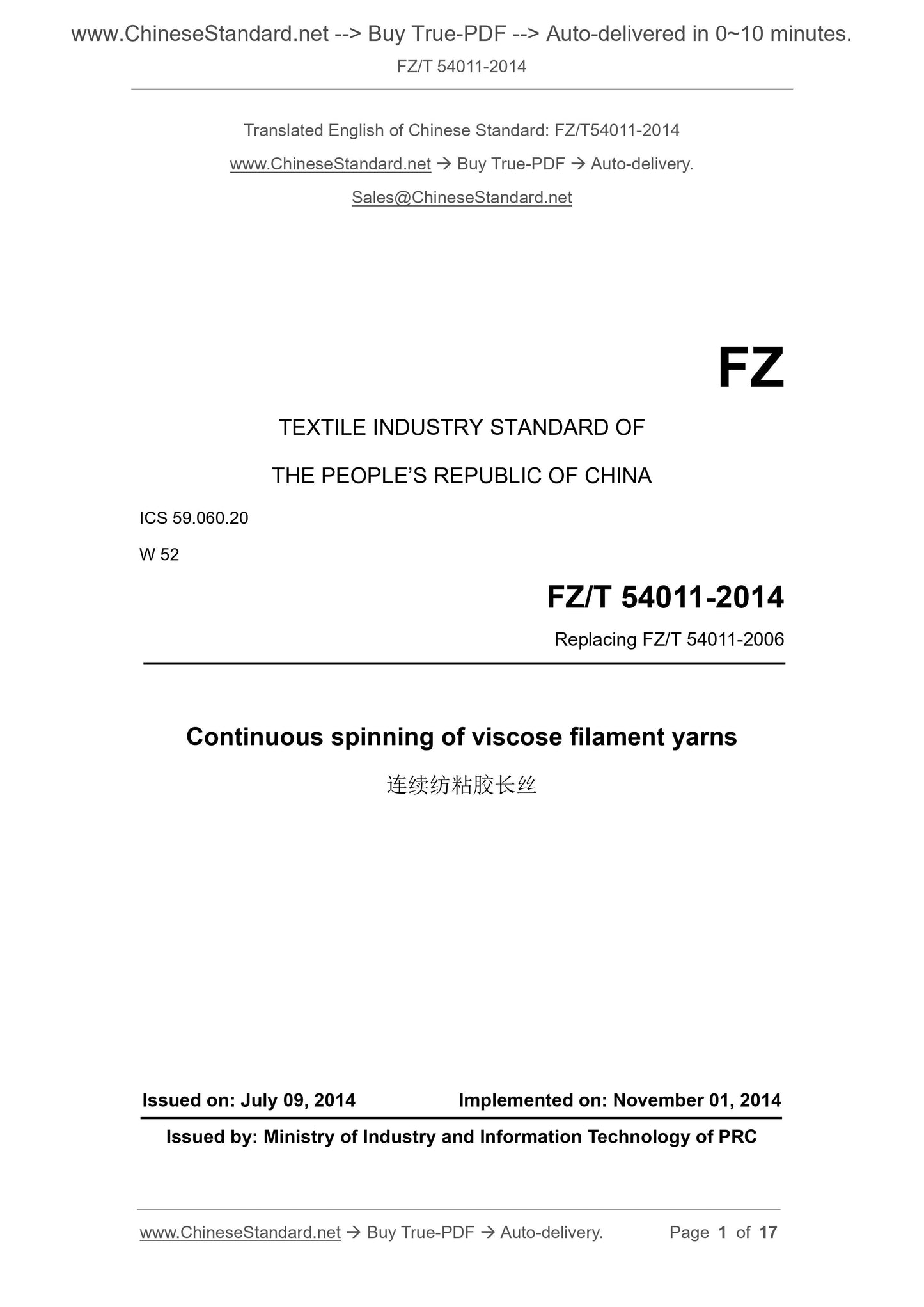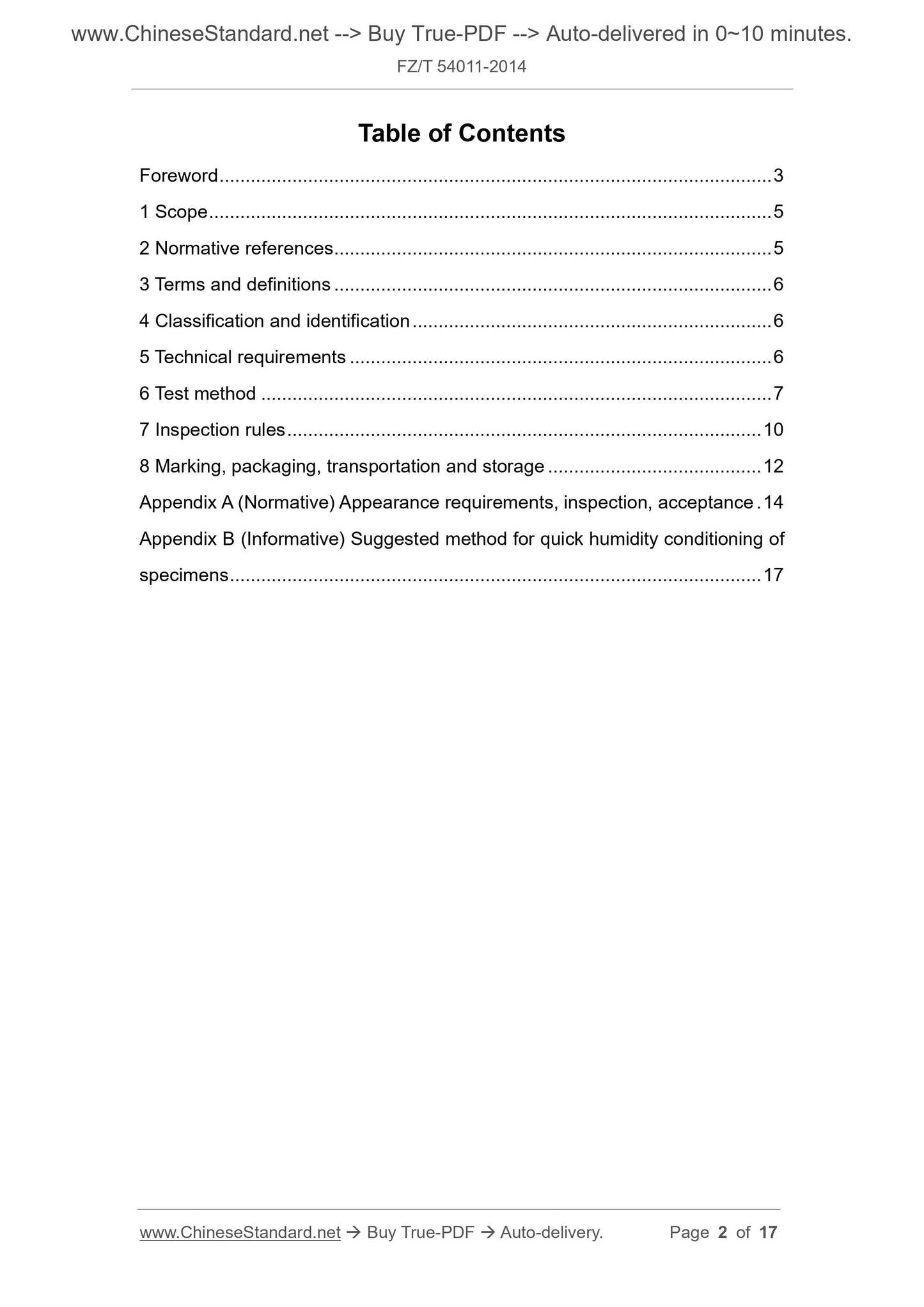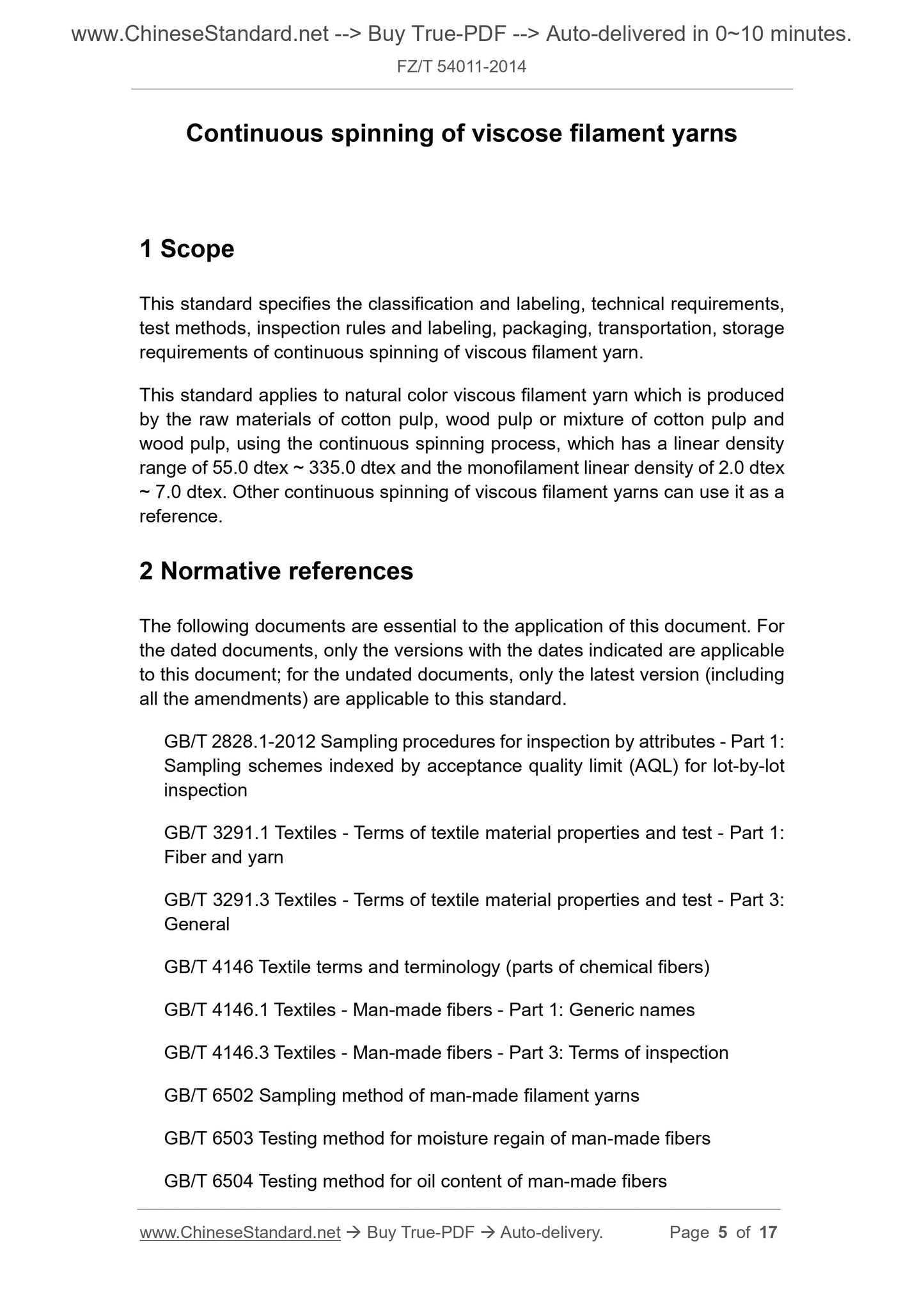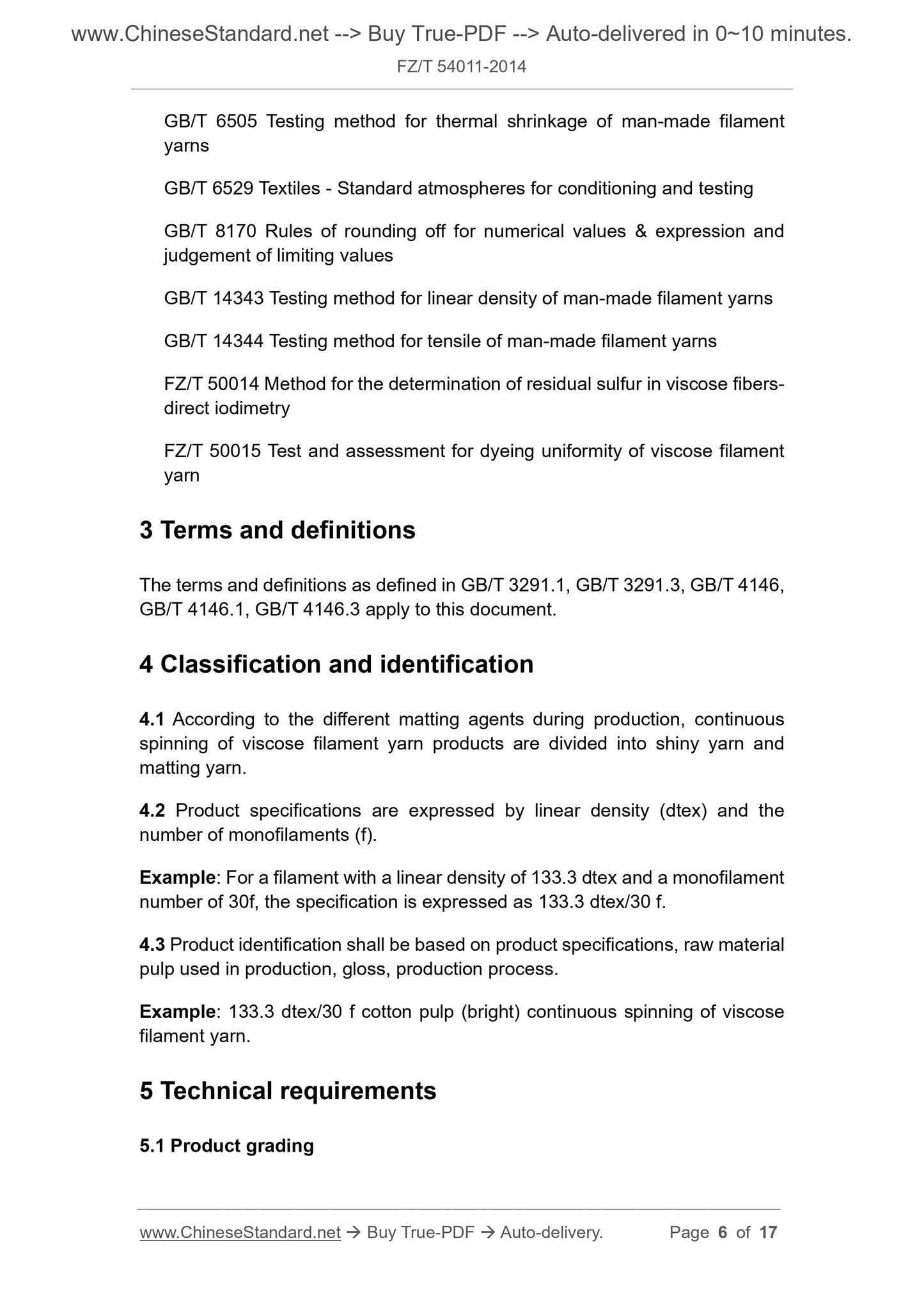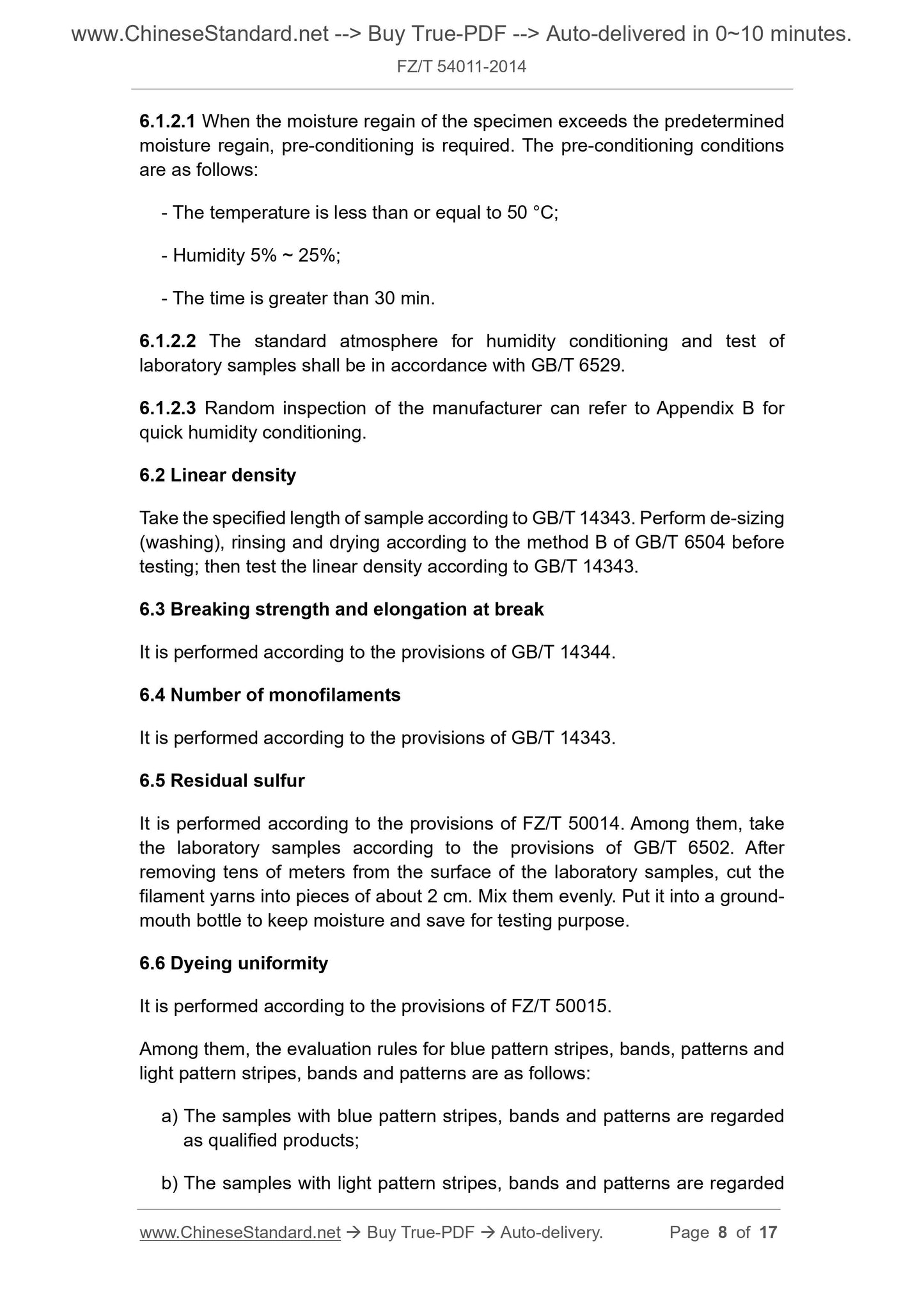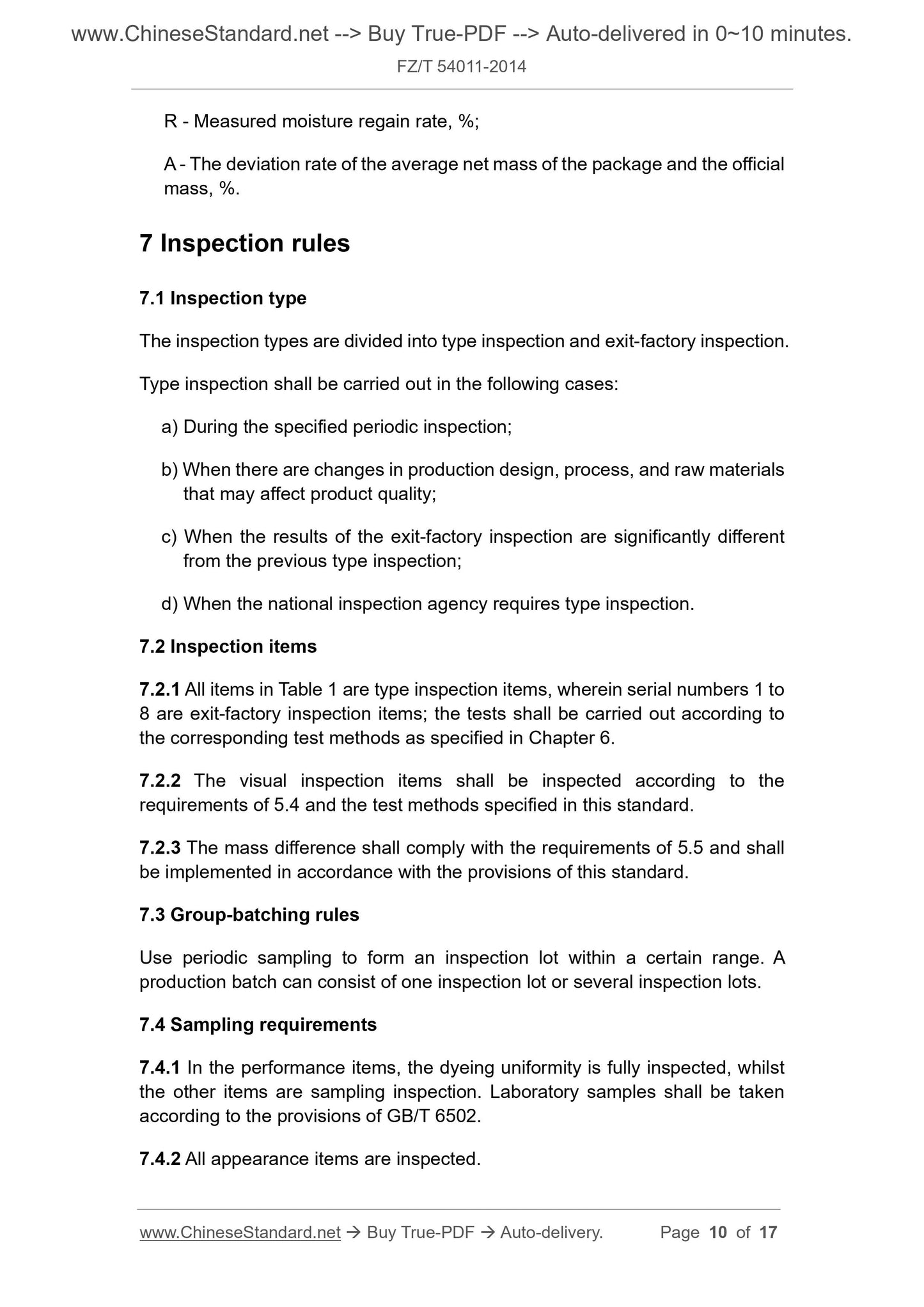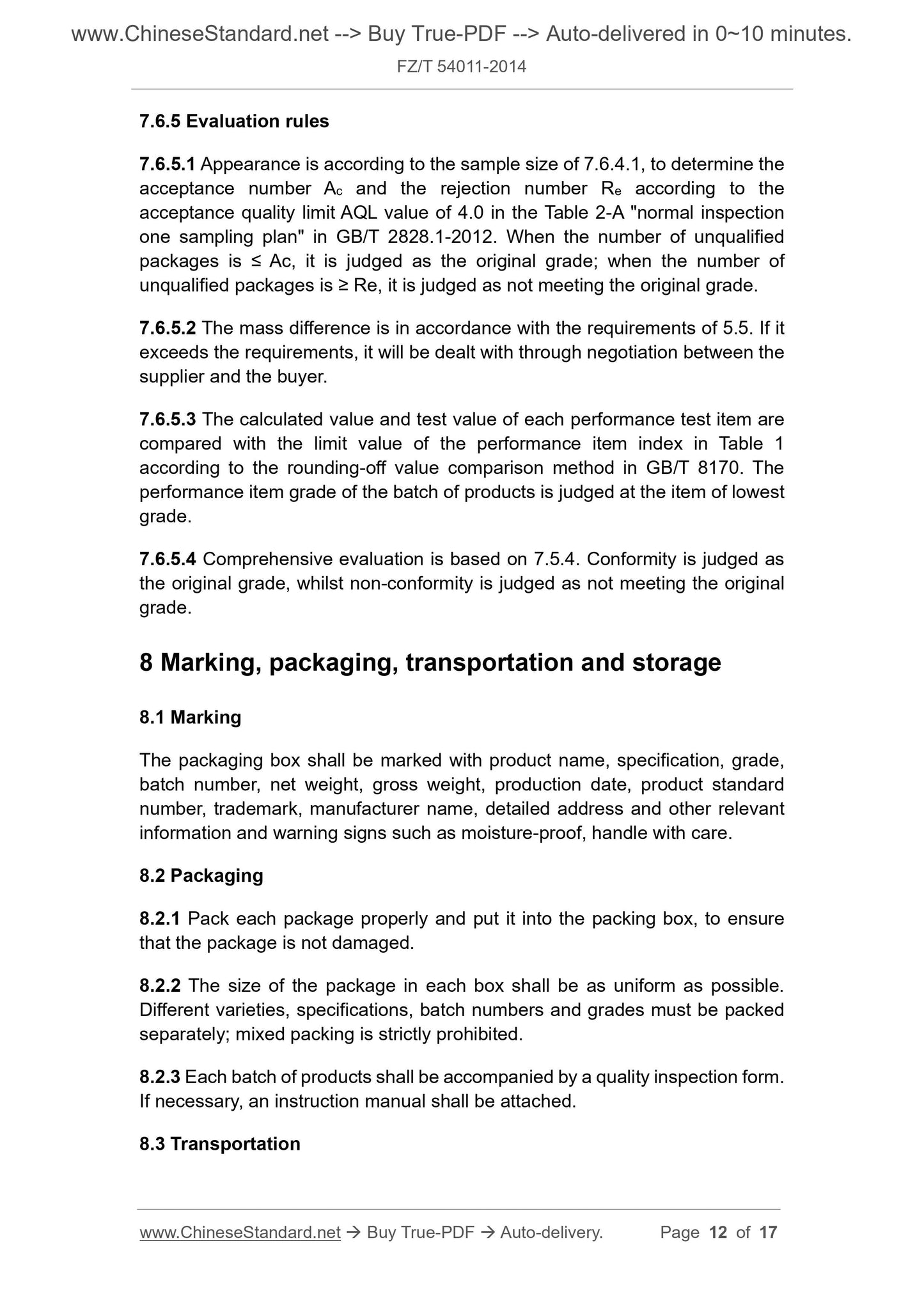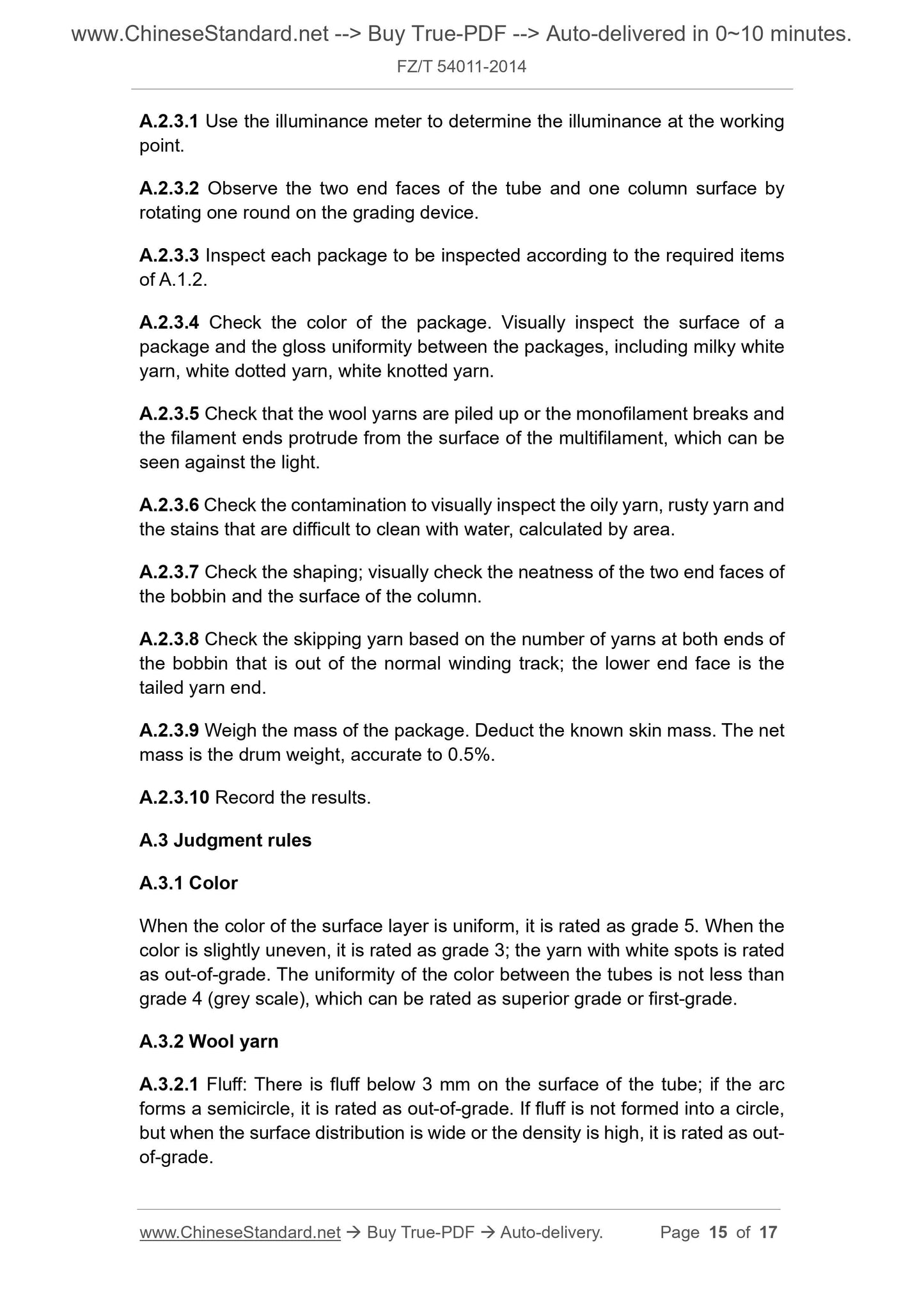1
/
の
8
PayPal, credit cards. Download editable-PDF and invoice in 1 second!
FZ/T 54011-2014 English PDF (FZT54011-2014)
FZ/T 54011-2014 English PDF (FZT54011-2014)
通常価格
$210.00 USD
通常価格
セール価格
$210.00 USD
単価
/
あたり
配送料はチェックアウト時に計算されます。
受取状況を読み込めませんでした
Delivery: 3 seconds. Download true-PDF + Invoice.
Get QUOTATION in 1-minute: Click FZ/T 54011-2014
Historical versions: FZ/T 54011-2014
Preview True-PDF (Reload/Scroll if blank)
FZ/T 54011-2014: Continuous spinning of viscose filament yarns
FZ/T 54011-2014
FZ
TEXTILE INDUSTRY STANDARD OF
THE PEOPLE’S REPUBLIC OF CHINA
ICS 59.060.20
W 52
Replacing FZ/T 54011-2006
Continuous spinning of viscose filament yarns
连续纺粘胶长丝
ISSUED ON: JULY 09, 2014
IMPLEMENTED ON: NOVEMBER 01, 2014
Issued by: Ministry of Industry and Information Technology of PRC
Table of Contents
Foreword ... 3
1 Scope ... 5
2 Normative references ... 5
3 Terms and definitions ... 6
4 Classification and identification ... 6
5 Technical requirements ... 6
6 Test method ... 7
7 Inspection rules ... 10
8 Marking, packaging, transportation and storage ... 12
Appendix A (Normative) Appearance requirements, inspection, acceptance . 14
Appendix B (Informative) Suggested method for quick humidity conditioning of
specimens ... 17
Continuous spinning of viscose filament yarns
1 Scope
This standard specifies the classification and labeling, technical requirements,
test methods, inspection rules and labeling, packaging, transportation, storage
requirements of continuous spinning of viscous filament yarn.
This standard applies to natural color viscous filament yarn which is produced
by the raw materials of cotton pulp, wood pulp or mixture of cotton pulp and
wood pulp, using the continuous spinning process, which has a linear density
range of 55.0 dtex ~ 335.0 dtex and the monofilament linear density of 2.0 dtex
~ 7.0 dtex. Other continuous spinning of viscous filament yarns can use it as a
reference.
2 Normative references
The following documents are essential to the application of this document. For
the dated documents, only the versions with the dates indicated are applicable
to this document; for the undated documents, only the latest version (including
all the amendments) are applicable to this standard.
GB/T 2828.1-2012 Sampling procedures for inspection by attributes - Part 1:
Sampling schemes indexed by acceptance quality limit (AQL) for lot-by-lot
inspection
GB/T 3291.1 Textiles - Terms of textile material properties and test - Part 1:
Fiber and yarn
GB/T 3291.3 Textiles - Terms of textile material properties and test - Part 3:
General
GB/T 4146 Textile terms and terminology (parts of chemical fibers)
GB/T 4146.1 Textiles - Man-made fibers - Part 1: Generic names
GB/T 4146.3 Textiles - Man-made fibers - Part 3: Terms of inspection
GB/T 6502 Sampling method of man-made filament yarns
GB/T 6503 Testing method for moisture regain of man-made fibers
GB/T 6504 Testing method for oil content of man-made fibers
GB/T 6505 Testing method for thermal shrinkage of man-made filament
yarns
GB/T 6529 Textiles - Standard atmospheres for conditioning and testing
GB/T 8170 Rules of rounding off for numerical values and expression and
judgement of limiting values
GB/T 14343 Testing method for linear density of man-made filament yarns
GB/T 14344 Testing method for tensile of man-made filament yarns
FZ/T 50014 Method for the determination of residual sulfur in viscose fibers-
direct iodimetry
FZ/T 50015 Test and assessment for dyeing uniformity of viscose filament
yarn
3 Terms and definitions
The terms and definitions as defined in GB/T 3291.1, GB/T 3291.3, GB/T 4146,
GB/T 4146.1, GB/T 4146.3 apply to this document.
4 Classification and identification
4.1 According to the different matting agents during production, continuous
spinning of viscose filament yarn products are divided into shiny yarn and
matting yarn.
4.2 Product specifications are expressed by linear density (dtex) and the
number of monofilaments (f).
Example: For a filament with a linear density of 133.3 dtex and a monofilament
number of 30f, the specification is expressed as 133.3 dtex/30 f.
4.3 Product identification shall be based on product specifications, raw material
pulp used in production, gloss, production process.
Example: 133.3 dtex/30 f cotton pulp (bright) continuous spinning of viscose
filament yarn.
5 Technical requirements
5.1 Product grading
6.1.2.1 When the moisture regain of the specimen exceeds the predetermined
moisture regain, pre-conditioning is required. The pre-conditioning conditions
are as follows:
- The temperature is less than or equal to 50 °C;
- Humidity 5% ~ 25%;
- The time is greater than 30 min.
6.1.2.2 The standard atmosphere for humidity conditioning and test of
laboratory samples shall be in accordance with GB/T 6529.
6.1.2.3 Random inspection of the manufacturer can refer to Appendix B for
quick humidity conditioning.
6.2 Linear density
Take the specified length of sample according to GB/T 14343. Perform de-sizing
(washing), rinsing and drying according to the method B of GB/T 6504 before
testing; then test the linear density according to GB/T 14343.
6.3 Breaking strength and elongation at break
It is performed according to the provisions of GB/T 14344.
6.4 Number of monofilaments
It is performed according to the provisions of GB/T 14343.
6.5 Residual sulfur
It is performed according to the provisions of FZ/T 50014. Among them, take
the laboratory samples according to the provisions of GB/T 6502. After
removing tens of meters from the surface of the laboratory samples, cut the
filament yarns into pieces of about 2 cm. Mix them evenly. Put it into a ground-
mouth bottle to keep moisture and save for testing purpose.
6.6 Dyeing uniformity
It is performed according to the provisions of FZ/T 50015.
Among them, the evaluation rules for blue pattern stripes, bands, patterns and
light pattern stripes, bands and patterns are as follows:
a) The samples with blue pattern stripes, bands and patterns are regarded
as qualified products;
b) The samples with light pattern stripes, bands and patterns are regarded
R - Measured moisture regain rate, %;
A - The deviation rate of the average net mass of the package and the official
mass, %.
7 Inspection rules
7.1 Inspection type
The inspection types are divided into type inspection and exit-factory inspection.
Type inspection shall be carried out in the following cases:
a) During the specified periodic inspection;
b) When there are changes in production design, process, and raw materials
that may affect product quality;
c) When the results of the exit-factory inspection are significantly different
from the previous type inspection;
d) When the national inspection agency requires type inspection.
7.2 Inspection items
7.2.1 All items in Table 1 are type inspection items, wherein serial numbers 1 to
8 are exit-factory inspection items; the tests shall be carried out according to
the corresponding test methods as specified in Chapter 6.
7.2.2 The visual inspection items shall be inspected according to the
requirements of 5.4 and the test methods specified in this standard.
7.2.3 The mass difference shall comply with the requirements of 5.5 and shall
be implemented in accordance with the provisions of this standard.
7.3 Group-batching rules
Use periodic sampling to form an inspection lot within a certain range. A
production batch can consist of one inspection lot or several inspection lots.
7.4 Sampling requirements
7.4.1 In the performance items, the dyeing uniformity is fully inspected, whilst
the other items are sampling inspection. Laboratory samples shall be taken
according to the provisions of GB/T 6502.
7.4.2 All appearance items are inspected.
7.6.5 Evaluation rules
7.6.5.1 Appearance is according to the ...
Get QUOTATION in 1-minute: Click FZ/T 54011-2014
Historical versions: FZ/T 54011-2014
Preview True-PDF (Reload/Scroll if blank)
FZ/T 54011-2014: Continuous spinning of viscose filament yarns
FZ/T 54011-2014
FZ
TEXTILE INDUSTRY STANDARD OF
THE PEOPLE’S REPUBLIC OF CHINA
ICS 59.060.20
W 52
Replacing FZ/T 54011-2006
Continuous spinning of viscose filament yarns
连续纺粘胶长丝
ISSUED ON: JULY 09, 2014
IMPLEMENTED ON: NOVEMBER 01, 2014
Issued by: Ministry of Industry and Information Technology of PRC
Table of Contents
Foreword ... 3
1 Scope ... 5
2 Normative references ... 5
3 Terms and definitions ... 6
4 Classification and identification ... 6
5 Technical requirements ... 6
6 Test method ... 7
7 Inspection rules ... 10
8 Marking, packaging, transportation and storage ... 12
Appendix A (Normative) Appearance requirements, inspection, acceptance . 14
Appendix B (Informative) Suggested method for quick humidity conditioning of
specimens ... 17
Continuous spinning of viscose filament yarns
1 Scope
This standard specifies the classification and labeling, technical requirements,
test methods, inspection rules and labeling, packaging, transportation, storage
requirements of continuous spinning of viscous filament yarn.
This standard applies to natural color viscous filament yarn which is produced
by the raw materials of cotton pulp, wood pulp or mixture of cotton pulp and
wood pulp, using the continuous spinning process, which has a linear density
range of 55.0 dtex ~ 335.0 dtex and the monofilament linear density of 2.0 dtex
~ 7.0 dtex. Other continuous spinning of viscous filament yarns can use it as a
reference.
2 Normative references
The following documents are essential to the application of this document. For
the dated documents, only the versions with the dates indicated are applicable
to this document; for the undated documents, only the latest version (including
all the amendments) are applicable to this standard.
GB/T 2828.1-2012 Sampling procedures for inspection by attributes - Part 1:
Sampling schemes indexed by acceptance quality limit (AQL) for lot-by-lot
inspection
GB/T 3291.1 Textiles - Terms of textile material properties and test - Part 1:
Fiber and yarn
GB/T 3291.3 Textiles - Terms of textile material properties and test - Part 3:
General
GB/T 4146 Textile terms and terminology (parts of chemical fibers)
GB/T 4146.1 Textiles - Man-made fibers - Part 1: Generic names
GB/T 4146.3 Textiles - Man-made fibers - Part 3: Terms of inspection
GB/T 6502 Sampling method of man-made filament yarns
GB/T 6503 Testing method for moisture regain of man-made fibers
GB/T 6504 Testing method for oil content of man-made fibers
GB/T 6505 Testing method for thermal shrinkage of man-made filament
yarns
GB/T 6529 Textiles - Standard atmospheres for conditioning and testing
GB/T 8170 Rules of rounding off for numerical values and expression and
judgement of limiting values
GB/T 14343 Testing method for linear density of man-made filament yarns
GB/T 14344 Testing method for tensile of man-made filament yarns
FZ/T 50014 Method for the determination of residual sulfur in viscose fibers-
direct iodimetry
FZ/T 50015 Test and assessment for dyeing uniformity of viscose filament
yarn
3 Terms and definitions
The terms and definitions as defined in GB/T 3291.1, GB/T 3291.3, GB/T 4146,
GB/T 4146.1, GB/T 4146.3 apply to this document.
4 Classification and identification
4.1 According to the different matting agents during production, continuous
spinning of viscose filament yarn products are divided into shiny yarn and
matting yarn.
4.2 Product specifications are expressed by linear density (dtex) and the
number of monofilaments (f).
Example: For a filament with a linear density of 133.3 dtex and a monofilament
number of 30f, the specification is expressed as 133.3 dtex/30 f.
4.3 Product identification shall be based on product specifications, raw material
pulp used in production, gloss, production process.
Example: 133.3 dtex/30 f cotton pulp (bright) continuous spinning of viscose
filament yarn.
5 Technical requirements
5.1 Product grading
6.1.2.1 When the moisture regain of the specimen exceeds the predetermined
moisture regain, pre-conditioning is required. The pre-conditioning conditions
are as follows:
- The temperature is less than or equal to 50 °C;
- Humidity 5% ~ 25%;
- The time is greater than 30 min.
6.1.2.2 The standard atmosphere for humidity conditioning and test of
laboratory samples shall be in accordance with GB/T 6529.
6.1.2.3 Random inspection of the manufacturer can refer to Appendix B for
quick humidity conditioning.
6.2 Linear density
Take the specified length of sample according to GB/T 14343. Perform de-sizing
(washing), rinsing and drying according to the method B of GB/T 6504 before
testing; then test the linear density according to GB/T 14343.
6.3 Breaking strength and elongation at break
It is performed according to the provisions of GB/T 14344.
6.4 Number of monofilaments
It is performed according to the provisions of GB/T 14343.
6.5 Residual sulfur
It is performed according to the provisions of FZ/T 50014. Among them, take
the laboratory samples according to the provisions of GB/T 6502. After
removing tens of meters from the surface of the laboratory samples, cut the
filament yarns into pieces of about 2 cm. Mix them evenly. Put it into a ground-
mouth bottle to keep moisture and save for testing purpose.
6.6 Dyeing uniformity
It is performed according to the provisions of FZ/T 50015.
Among them, the evaluation rules for blue pattern stripes, bands, patterns and
light pattern stripes, bands and patterns are as follows:
a) The samples with blue pattern stripes, bands and patterns are regarded
as qualified products;
b) The samples with light pattern stripes, bands and patterns are regarded
R - Measured moisture regain rate, %;
A - The deviation rate of the average net mass of the package and the official
mass, %.
7 Inspection rules
7.1 Inspection type
The inspection types are divided into type inspection and exit-factory inspection.
Type inspection shall be carried out in the following cases:
a) During the specified periodic inspection;
b) When there are changes in production design, process, and raw materials
that may affect product quality;
c) When the results of the exit-factory inspection are significantly different
from the previous type inspection;
d) When the national inspection agency requires type inspection.
7.2 Inspection items
7.2.1 All items in Table 1 are type inspection items, wherein serial numbers 1 to
8 are exit-factory inspection items; the tests shall be carried out according to
the corresponding test methods as specified in Chapter 6.
7.2.2 The visual inspection items shall be inspected according to the
requirements of 5.4 and the test methods specified in this standard.
7.2.3 The mass difference shall comply with the requirements of 5.5 and shall
be implemented in accordance with the provisions of this standard.
7.3 Group-batching rules
Use periodic sampling to form an inspection lot within a certain range. A
production batch can consist of one inspection lot or several inspection lots.
7.4 Sampling requirements
7.4.1 In the performance items, the dyeing uniformity is fully inspected, whilst
the other items are sampling inspection. Laboratory samples shall be taken
according to the provisions of GB/T 6502.
7.4.2 All appearance items are inspected.
7.6.5 Evaluation rules
7.6.5.1 Appearance is according to the ...
Share
